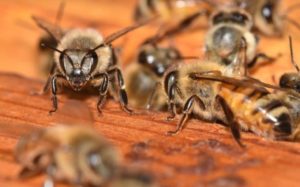Honeybees vs. Bumble Bees
Honeybees and bumble bees are two of the most common species in the Mid-Atlantic. If you live or work near areas with an abundance of flowers, like gardens or fields, you may encounter these pests. While they may seem similar, there are many ways to tell the difference between a honeybee and bumble bee.
What Do Honeybees and Bumble Bees Look Like?
Honeybees are about half an inch long and have hairy bodies with black and yellow bands. On the other hand, while bumble bees have similar striping, they are more robust with a round build and more hair. This pest grows to about three-quarters of an inch in length.

Honey bees
Habits & Behavior
In the wild, honeybees set up colonies containing up to 60,000 bees in trees, rock crevices, and even in the wall voids of buildings. Farmers also place managed hives in fields to help pollinate crops. Bumble bees live in smaller groups of around 400. You might find these pests in thick grassy areas, abandoned animal nests, and underneath sheds.
Dangers of Honeybees and Bumble Bees
Both of these species are docile and won’t attack unless threatened or handled. The biggest difference between a honeybee and bumble bee is that the latter can sting more than once. Honeybees have barbed stingers that can remain in your skin. If stung by either, swollen red welts can form, but those who are allergic may experience a more serious reaction.
While honeybees and bumble bees offer many benefits, the insects may cause concern in places where people gather. This is especially true if bees create nests around a doorway, on a restaurant patio, or inside a school playground. If you have a bumble bee or honeybee problem, contact Western Pest Services today to consult with an expert.